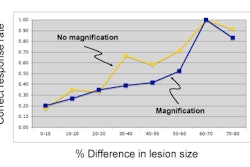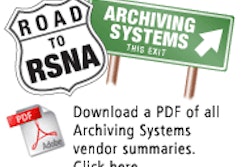Expanding digital healthcare information management systems (DHIMS) beyond the radiology department to handle all images in the enterprise can provide better patient care, save money, and even help the environment, according to Dr. Gary Wendt of the University of Wisconsin in Madison.
"If you start looking at DHIMS as not just a radiology-type focus, but rather an enterprise or multienterprise resource, you'll help improve patient care, reduce the cost of providing patient care, and help provide a little bit of a greener environment by reducing your carbon footprint," he said. "You won't have so many different servers and so many different archives sitting out there."
Wendt spoke during a presentation at the DHIMS 2008 meeting in March in San Antonio.
Of course, enterprise image management brings challenges as well, including the need to address all areas that film is used, such as the operating room, physician offices, and conference rooms, according to Wendt. Their needs may be different than those of the radiology department.
"What dermatology wants to do with images for conferences, what pathology wants to do with images for conferences, may be quite different than what radiology is used to using," he said.
The PACS or DHIMS team must be willing to help other groups solve their image distribution challenges, Wendt said.
Switching to enterprise image management can improve patient care in much the same way PACS did. It can also save money, including film/chart costs and "object" movement costs such as film and "shadow" charts (copies of patient records used by departments), he said.
At the university, a project to reduce the movement of film jackets by 90% and reduce film use in targeted areas led to film generation savings of $100,000 and film jacket movement project savings of $1.5 million, Wendt said.
"Virtually every other department that uses images will have the exact same thing as a radiology file room, only it's called various different things," he said. "Oftentimes, senior administration doesn't even know it exists."
Expanding the vision of radiology DHIMS to other clinical departments will allow institutions to realize the proven benefits of radiology DHIMS throughout the enterprise, improve the effectiveness of the clinical team with a single point of image display, improve patient care with a more integrated record, and improve the speed of clinical care, Wendt said.
It also allows institutions to replicate the success in radiology everywhere, and provides universal filmless access to images, a single system infrastructure, and integrated operational workflow, Wendt said.
Once you've decided to expand to enterprise medical image management, you need to create a road map, Wendt said.
"Make sure you look at every area in your enterprise and understand where the technology is at in your environment," he said. "That's going to be another big driving factor. Every one of your departments is not going to be ready to go into a digital image management environment."
It's also a good idea to start with a group that wants to transition to the new environment, rather than a department that's happy with the way they're doing things, Wendt said.
"If you can get a group that's really technologically savvy and get them on board, it sells all of the other groups in the hospital," he said. "Once they start seeing the benefits of this, you'll have people coming to you."
A DHIMS system is the best tool to manage medical images from all areas in the enterprise, Wendt said.
"A DHIMS system understands the concept of 'like priors,' " he said. "You really want a system that knows how to manage the images."
Images are generated in various departments around the enterprise, including bronchoscopy, endoscopy, laparoscopy, arthroscopy, ophthalmology, otolaryngology, and pathology, according to Wendt. Each department has its own unique needs.
"Your medical enterprise has significant imaging volume beyond radiology, and DHIMS is a significant investment with a proven ROI," he said.
By Erik L. Ridley
AuntMinnie.com staff writer
April 21, 2008
Related Reading
Advanced visualization's benefits come with integration challenges, April 7, 2008
Buying a RIS/PACS for a distributed radiology practice requires careful planning, March 31, 2008
Planning eases PACS upgrade woes, vendor changes, March 27, 2008
Web-based issue-tracking system boosts radiology QC, April 4, 2008
Effective communication is crucial for radiology department success, March 20, 2008
Copyright © 2008 AuntMinnie.com



















